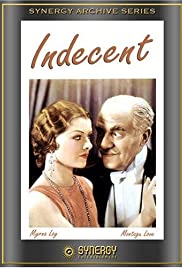
VANITY FAIR
US, 1932, 78 minutes, Black and white.
Myrna Loy, Conway Tearle, Barbara Kent, Walter Byron, Anthony Bushell, Billy Bevan, Montague Love, Herbert Bunston, Mary Forbes, Lionel Belmore.
Directed by Chester M. Franklin.
This is a brief version of Thackeray’s Vanity Fair, soon to be filmed under the title Becky Sharp with Miriam Hopkins in the title role, the first full-length technicolour film. While there have been several versions for television, the biggest-budget version was the 2004 Mira Nair version with Reese Witherspoon.
This version was written by the comedian F. Hugh Herbert. And, it is updated to the 1930s, with the British setting. There is none of the Napoleonic War background, or any war, as in the novel.
In many ways, this is very much an abbreviated version, although it does highlight the central characters and the basic themes.
It was a star version for Myrna Loy, who is coldly calculating in the role but not without being able to exert some charm, especially for the men who are foolish enough to believe her. She arrives at the Sedley household for a Christmas celebration with her school friend, Amelia, played by Barbara Kent. She is welcome by the Sedleys but it is clear that she resents her poverty and lack of status, is envious of Amelia, and is prepared to marry any man so that she will get wealth and/or position. Amelia’s brother, Joseph, drunkenly agrees to marry her but then wants to back out.
There are the various men characters from Thackeray’s novel – all presented as rather worthless, with touches of the sleazy, Sir Pitt Crawley who can’t wait for his wife to die so that he can exploit Becky, the tutor for his children. Then there is his son, Rawdon, who carries on an affair with Becky, very soon after her arrival, and whom she marries despite the fact that he is cut off from wealth by his father. There is also George Osborne, Amelia’s fiance and then husband, who arranges a rendezvous with Becky, with a telegram that she keeps and is able to show to Amelia to disillusion her about her husband who has died in a riding accident some years before.
The only decent man is William Dobbin, played by British actor Anthony Bushell, devoted to Amelia, believing George Osborne to be good, despising Becky but having to believe the ill-fated message.
Becky and Rawdon use their wits come in to survive, eventually gambling at bridge. At one stage, Gordon is arrested for money matters, which are paid for by Dobbin, and then arrives home to find his wife flirting with another wealthy possible suitor.
Things go from bad to worse for Becky, on the continent, gambling and cheating, expelled from her boarding house – but later meeting Joseph Sedley again, colluding with him. When, by chance, Dobbin and Amelia arrive, there is something of a reunion but Becky shows a moment of goodwill to Amelia by revealing the truth about her husband.
The film ends with Becky looking with a long gaze into a mirror, shedding tears at her ruin – an ending which was to be very effective in Stephen Frears’ Dangerous Liaison, with Glenn Close also looking into a mirror and shedding a tear.
It is interesting to realise that Hollywood was making brief versions of classics, as they did in silent film times. Another film of this time was Unholy Love, a version of Flaubert’s Madame Bovary, set in New York State.